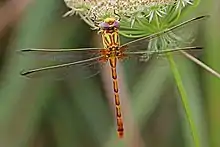Erpetogomphus
Erpetogomphus is a genus of dragonfly in the family Gomphidae. They are commonly known as ringtails. Most of the species are predominantly green coloured and the males have a moderately clubbed tail.[1] A fossil species is known from the Miocene Mexican amber[2]
| Erpetogomphus | |
|---|---|
 | |
| Erpetogomphus designatus | |
| Scientific classification | |
| Kingdom: | |
| Phylum: | |
| Class: | |
| Order: | |
| Family: | |
| Genus: | Erpetogomphus Selys, 1858 |
The genus contains the following species:[3]
- Erpetogomphus agkistrodon Garrison, 1994
- Erpetogomphus boa Selys, 1859
- Erpetogomphus bothrops Garrison, 1994 – one-striped ringtail[4]
- Erpetogomphus compositus Hagen in Selys, 1858 – white-belted ringtail[5]
- Erpetogomphus constrictor Ris, 1918 – knob-tipped ringtail[6]
- Erpetogomphus cophias Selys, 1858
- Erpetogomphus crotalinus (Hagen in Selys, 1854) – yellow-legged ringtail[5]
- Erpetogomphus designatus Hagen in Selys, 1858 – eastern ringtail[5]
- Erpetogomphus elaphe Garrison, 1994
- Erpetogomphus elaps Selys, 1858 – straight-tipped ringtail[5]
- Erpetogomphus erici Novelo & Garrison, 1999
- Erpetogomphus eutainia Calvert, 1905 – blue-faced ringtail[5]
- Erpetogomphus heterodon Garrison, 1994 – dashed ringtail[5]
- Erpetogomphus lampropeltis Kennedy, 1918 – serpent ringtail[5]
- Erpetogomphus leptophis Garrison, 1994 – dark-shouldered ringtail[7]
- Erpetogomphus liopeltis Garrison, 1994
- Erpetogomphus ophibolus Calvert, 1905
- Erpetogomphus sabaleticus Williamson, 1918
- Erpetogomphus schausi Calvert, 1919
- Erpetogomphus sipedon Calvert, 1905
- Erpetogomphus tristani Calvert, 1912
- Erpetogomphus viperinus Selys, 1868
References
- Paulson, Dennis R. (2009). Dragonflies and Damselflies of the West. Princeton University Press. ISBN 0-691-12281-4.
- Zheng, Daran; Nel, André; Jarzembowski, Edmund A.; Chang, Su-Chin; Zhang, Haichun; Wang, Bo (2019-01-02). "Exceptionally well-preserved dragonflies (Insecta: Odonata) in Mexican amber". Alcheringa: An Australasian Journal of Palaeontology. 43 (1): 157–164. doi:10.1080/03115518.2018.1456562. ISSN 0311-5518.
- Martin Schorr; Dennis Paulson. "World Odonata List". University of Puget Sound. Retrieved 12 Oct 2018.
- Paulson, D. R. (2009). "Erpetogomphus bothrops". IUCN Red List of Threatened Species. 2009: e.T165051A5975649. doi:10.2305/IUCN.UK.2009-2.RLTS.T165051A5975649.en. Retrieved 24 December 2017.
- "North American Odonata". University of Puget Sound. 2009. Retrieved 5 August 2010.
- Paulson, D. R. (2009). "Erpetogomphus constrictor". IUCN Red List of Threatened Species. 2009: e.T164984A5952895. doi:10.2305/IUCN.UK.2009-2.RLTS.T164984A5952895.en. Retrieved 24 December 2017.
- Paulson, D. R. (2009). "Erpetogomphus liopeltis". IUCN Red List of Threatened Species. 2009: e.T165021A5965113. doi:10.2305/IUCN.UK.2009-2.RLTS.T165021A5965113.en. Retrieved 24 December 2017.
This article is issued from Wikipedia. The text is licensed under Creative Commons - Attribution - Sharealike. Additional terms may apply for the media files.